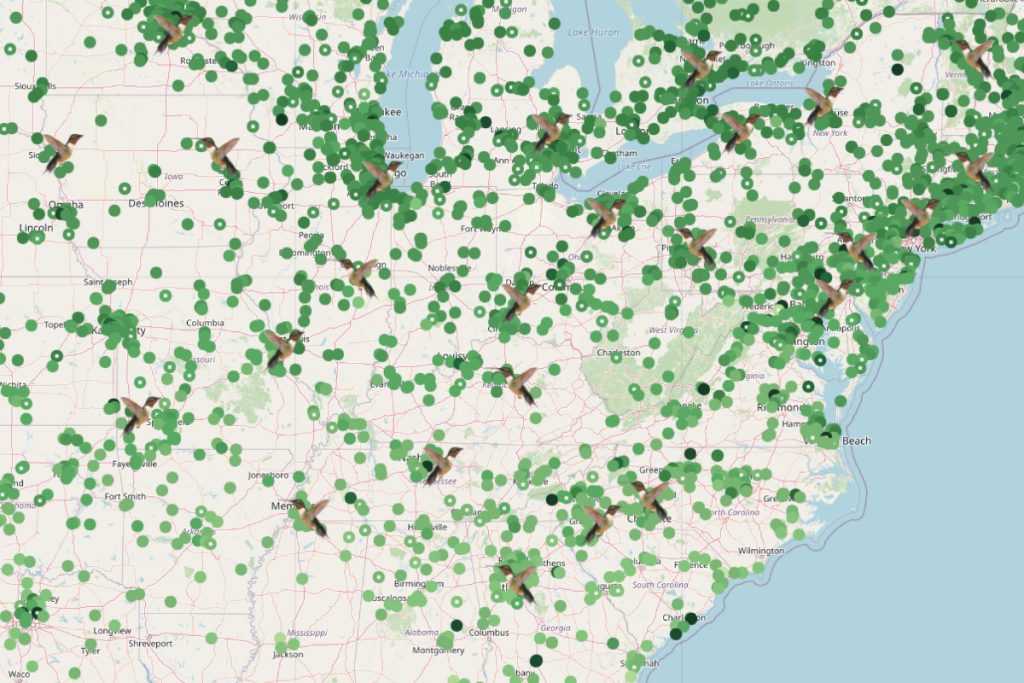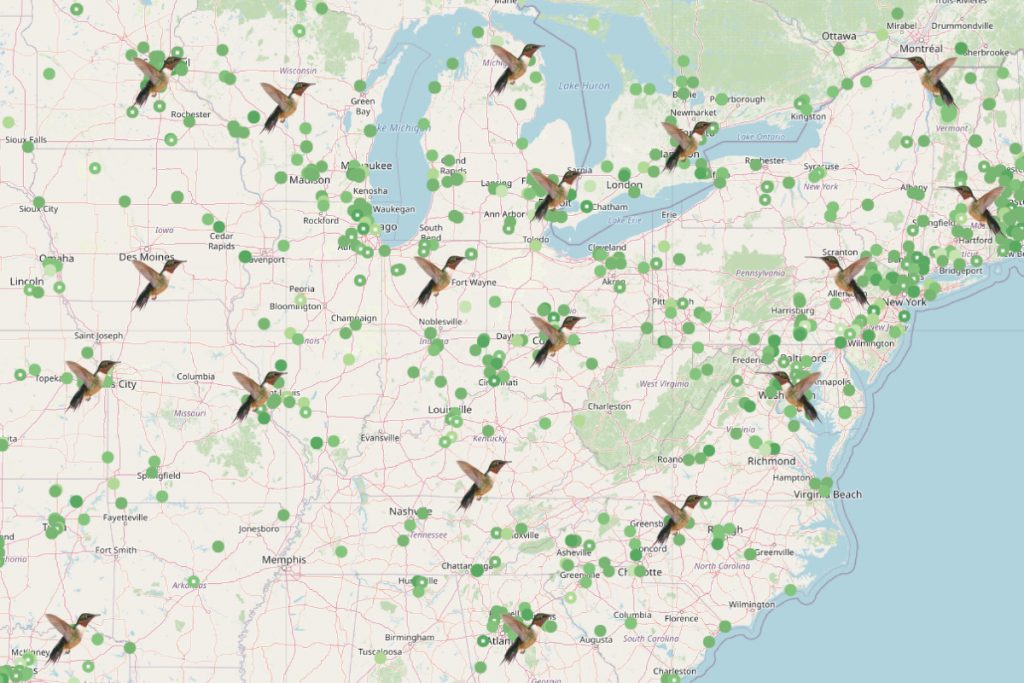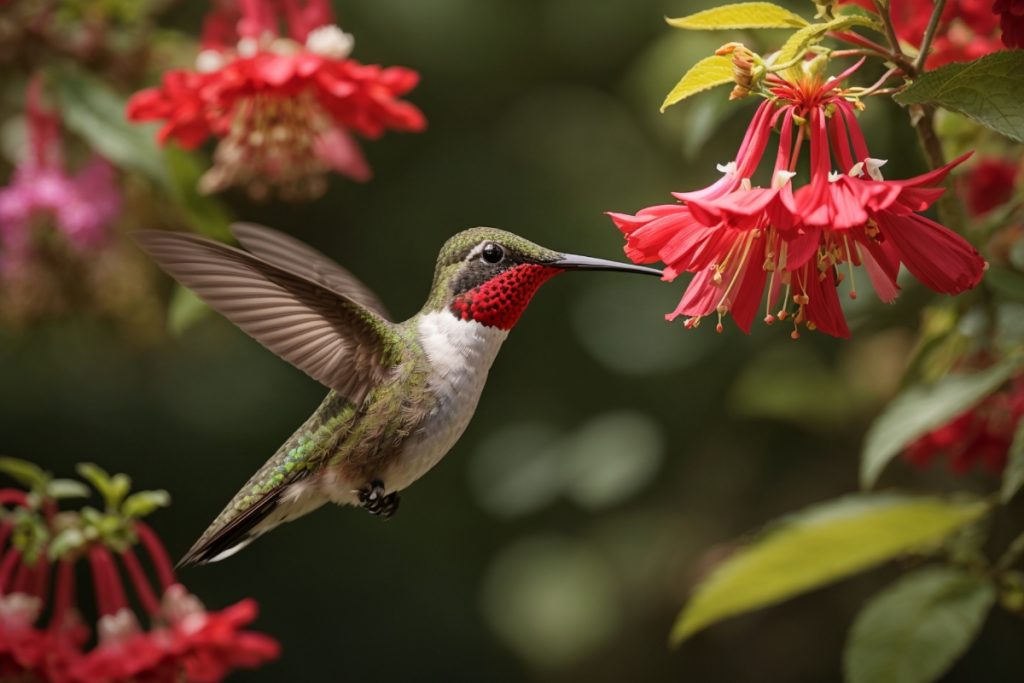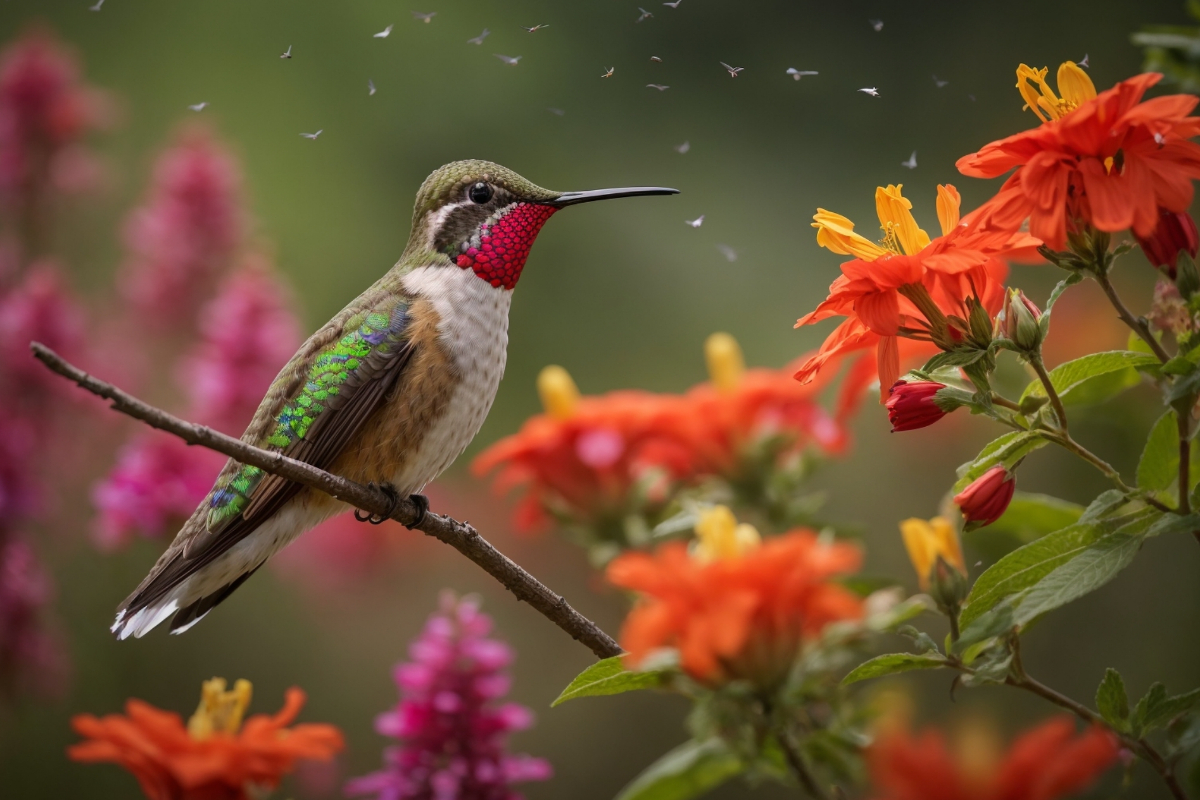Every year, the ruby-throated hummingbird makes an incredible journey across North America. Small enough to fit in the palm of your hand, these tiny birds undertake an annual migration of over 2,000 miles between their breeding grounds in Canada and the United States to their wintering grounds in Mexico and Central America.
Their migratory path forms a giant loop that crosses mountains, deserts, forests, and more. In this blog post, we will take a closer look at the ruby-throated hummingbird’s migration route, the challenges they face along the way, and how we can support these resilient travellers on their extraordinary journey.
Key Takeaways
- Migration Route and Timing: Ruby-throated hummingbirds travel over 2,000 miles annually between North America and Central America. Their migrations align with seasonal changes.
- Factors Influencing Migration: Migration is determined by food availability, weather, and daylight. They use landmarks, stars, and magnetic fields for navigation.
- Preparation and Challenges: Before migrating, Ruby-Throats build fat reserves and undergo physiological changes. They face obstacles like food scarcity, predators, and severe weather.
- Support and Monitoring: We can aid their migration by offering nectar shelter and planting native flowers. Monitoring techniques help track their migration patterns.
Related post to read about Best Hummingbird Feeders
Where Do Ruby-Throated Hummingbirds Migrate To?
The ruby-throated hummingbird is the only breeding hummingbird in most of eastern North America. They summer throughout the United States east of the Great Plains and across southern Canada, with the majority of the population spending winters in Mexico and Central America.

Ruby-Throated Hummingbird’s Spring Migration Route and Timing
- As early as February, Ruby-Throats begin leaving their winter grounds in Mexico, Belize, Guatemala, and Panama to start the northward trip back to their breeding range. The first arrivals reach the Gulf Coast states of Louisiana, Alabama, and Florida in late February or early March.
- Through March and April, Ruby-Throats continue to push northward following the blooming of spring flowers and newly leafed trees. They travel up through the Mississippi Valley and along the Appalachian Mountains.
- By May, ruby-throated hummingbirds have reached the northern limits of their range across Canada and the upper Midwest, with some stray individuals occasionally reported even farther north in Alaska. The full migration can take 2-3 months for some individuals.

Ruby-Throated Hummingbirds Fall Migration Route and Timing
- In late summer, adult Ruby-Throats begin to depart the breeding grounds, followed by juveniles and females starting in August. The southbound fall migration follows a more direct inland route through Texas and Mexico into Central America.
- Peak migration occurs in September as cold weather descends across Canada and the northern United States. By late October, the vast majority have reached their wintering grounds in Mexico, with stragglers reported into November.
- Favourite stopover spots include areas with bright tubular flowers that provide vital nectar, like Texas wildflowers, Arizona canyons, and southern magnolia trees. Some Ruby-Throats even brave the 500-mile, nonstop crossing of the Gulf of Mexico!
What Factors Influence Their Migration?
Ruby-throated hummingbirds migrate in response to seasonal changes in flower availability, weather conditions, and length of daylight. Here are some key factors:
- Food Availability: Ruby throats time their migration to take advantage of flower blooms along their route, as nectar is their primary energy source. They depart the breeding grounds when food becomes scarce and arrive at the wintering grounds when flowers are plentiful.
- Weather Patterns: Colder temperatures and potential snowstorms in the north drive the birds south in the fall. Warming spring temperatures and rainfall trigger the return north. Ruby-throats also avoid regions with severe weather like hurricanes during migration.
- Navigation Mechanisms: In addition to using landmarks, Ruby-Throats utilise celestial cues from stars and the earth’s magnetic field to orient themselves on migration. Their navigation abilities are incredible for such tiny birds.
How Do They Prepare for the Journey?
The ruby-throated hummingbird makes special preparations before its arduous migration each year:
- Fat Storage: In the weeks before migrating, Ruby-Throats nearly doubled their body weight by building up fat reserves. This fat provides the energy needed to fuel migrations of hundreds of miles.
- Organ Changes: A hummingbird’s heart and flight muscles grow substantially larger before migration to enable the strenuous travel ahead. Their digestive system shrinks since they eat less while flying.
- Navigation Preparation: Young hummingbirds likely memorise key migration routes and landmarks during their first journey north as fledglings. Prior to migration, adults undergo ZENK expression in their brains, indicating navigation preparation.

Challenges Faced During Migration
During their spring and fall migrations, Ruby-Throats must overcome numerous threats and challenges along the way, including:
- Finding Food and Shelter: Ruby throats require reliable sources of nectar to fuel their metabolisms and flowering plants for rest stops. Poor weather can reduce food availability.
- Predators: From hawks and falcons to spiders and praying mantises, many animals prey on hummingbirds. Migrants are especially vulnerable when stopping to refuel. Staying vigilant is critical.
- Severe Weather: Storms, high winds, and precipitation can blow migrating hummingbirds hundreds of miles off course. Cold snaps and snowfalls pose deadly risks.
- Competition: Competing with other hummingbird species for food at stopover sites adds pressure during migration.
- Orientation: Natural barriers like the Gulf of Mexico require excellent navigation skills. Some migrating birds become disoriented by artificial light pollution.
Monitoring Hummingbird Migration
Scientists track ruby-throated hummingbird migrations in various ways to better understand their incredible journeys:
- Banding: Capturing, banding, and releasing hummingbirds provides information on migration routes and timing when banded birds are recaptured.
- Citizen Science: Programs like Journey North rely on citizen scientists reporting first spring sightings. This data maps the northward progression of migration.
- Radar Studies: Doppler weather radar has detected major hummingbird movements, like trans-Gulf migrations, using collective data from different radar technologies.
- Feather Analysis: Chemical analysis of feathers can reveal details about migration origins and habitat use.
- Genetic Studies: DNA analysis helps determine migration patterns between breeding and wintering hummingbird populations.

Supporting Ruby-Throats on Their Journeys
Here are some tips for providing ruby-throated hummingbirds with extra support and safe passage during their migration:
- Supply Nectar: Put up feeders with fresh sugar water (4 parts water to 1 part sugar) to provide critical energy. Leave feeders up through October. Or alternatively, you can keep the feeders up until at least two weeks after you spot the last hummingbirds.
- Provide Shelter: Keep tree branches or shrubs near feeders so hummingbirds have cover from predators. Leave some dead leaves for nesting material.
- Reduce Threats: Keep cats indoors, use hummingbird-safe pesticides, and turn off lights at night during peak migration.
- Plant Natives: Gardens with native nectar flowers like bee balm, columbine, and trumpet vines support migrating hummingbirds.
- Report Sightings: Share first spring sightings and unusual observations with Journey North or the hummingbird banding program.
Remarkable Ruby-Throat Abilities
The ruby-throated hummingbird’s migration is even more astounding when you consider their tiny size and unique abilities:
- Hovering Flight: Ruby-throats can beat their wings up to 53 times per second, enabling them to fly backwards and hover mid-air, critical skills during migration.
- Fat Storage: Relative to their size, Ruby-Throats nearly double their body weight before migration, equivalent to a 180-pound person gaining an extra 140 pounds!
- Heart Rate: A hummingbird’s heart rate can reach over 1,200 beats per minute during flight, and they take over 250 breaths per minute at rest. This allows them to power their metabolisms.
- Toughness: From burning up to 10,000 calories a day to flying nonstop 500-mile journeys over the ocean, Ruby-Throats are one of the toughest migrants in the animal kingdom!
Conclusion
The incredible yearly migratory journey by ruby-throated hummingbirds is nothing short of remarkable. These tiny, resilient birds circumvent every obstacle to return to their northern breeding grounds each spring, where we eagerly await their arrival.
With a greater understanding of their migration routes, challenges, and abilities, we can better support Ruby-Throats on their extraordinary travels.
I don’t know about you, but I can’t wait to hear the first high-pitched buzz of a ruby throat zipping by my head later this spring! It will signal the return of these incredible migratory wonders to our backyards and gardens once more.

FAQs on Ruby-Throated Hummingbird Migration Map
Q: When Can I Expect The First Hummingbird Sighting During The Migration Season?
A: The first arrivals of Ruby-Throats reach the Gulf Coast states in late February or early March, signifying the beginning of their spring migration.
Q: Are Ruby-Throated Hummingbirds The Only Migratory Hummingbird Species In North America?
A: No, while Ruby-Throated hummingbirds are prominent migratory species, there are other species, like Rufous hummingbirds, that also migrate across North America.
Q: How do scientists use a tracking map to monitor the journey of hummingbirds?
A: Scientists utilise techniques like bird banding, citizen science programs, and radar studies to create a tracking map that shows the hummingbirds’ migratory routes and timing.
Q: Where Do Ruby-Throated Hummingbirds Spend Their Summer Months?
A: They summer throughout the United States east of the Great Plains and across Canadian provinces.
Q: Do Hummingbirds Migrate To Warmer Climates In The Winter?
A: Yes, Ruby-Throated hummingbirds migrate to warmer climates like Mexico and Central America during the winter.
Q: Is There A Standard Hummingbird Food Recipe That Can Attract These Birds To My Backyard?
A: Yes! A simple and common Hummingbird Food Recipe involves mixing 4 parts water to 1 part sugar to provide critical energy to these amazing birds.
Q: Can I Watch Hummingbird Videos To Better Understand Their Behaviour?
A: Absolutely! There are numerous hummingbird videos online that showcase their unique flight patterns, feeding habits, and hummingbird activity during various seasons.
Q: How Can I Differentiate Between Common Hummingbirds Like The Ruby-Throated And The Rufous Hummingbirds?
A: While both are common hummingbirds, the Ruby-Throated is predominantly found in eastern North America, whereas Rufous hummingbirds have a broader range across the continent. Their colouring and patterns can also help in identification.
Q: Can I Use A Hummingbird Feeder To Encourage More Backyard Hummingbirds?
A: Yes, using a hummingbird feeder filled with sugar water can attract hummingbirds to your backyard, offering them a vital food source during their migration.
Q: Are There Other American Hummingbird Species Besides The Ruby-Throated?
A: Yes, in addition to the Ruby-Throated, there are several American hummingbird species, such as the black-chinned hummingbird and the Rufous hummingbird.
Q: When Is The Perfect Time To Set Up A Hummingbird Feeder In Anticipation Of Their Arrival In Spring?
A: Setting up a hummingbird feeder in late February or early March is ideal in anticipation of the first arrivals during the spring hummingbird migration.
Q: How Do I Ensure That I Have The Perfect Feeder For Attracting A Variety Of Hummingbird Species?
A: The perfect feeder should be clean, filled with the right sugar-water mixture, and ideally placed near flowering plants or trees that serve as natural nectar sources.
Q: Are There Any Tips For Feeding Hummingbirds In My Backyard During Hummingbird Season?
A: When feeding hummingbirds, ensure fresh sugar water is provided, keep the feeder clean, and place it in a location where the birds feel safe from predators.
Q: Can I Use My Hummingbird Observations To Contribute To Scientific Data?
A: Absolutely! Programmes like Journey North rely on citizen scientists to report their hummingbird observations, helping to track the northward progression of migration.
Q: Is Flower Nectar The Primary Food Source For Hummingbirds?
A: Yes, flower nectar is the primary energy source for hummingbirds, although they also consume insects for protein.
Q: Is There A Spring Hummingbird Migration Map Available?
A: Yes, organisations and researchers often publish spring hummingbird migration maps based on observations, radar data, and banding information.
Q: What Other Common Species Of Backyard Birds Can I Expect Along With Hummingbirds?
A: Along with hummingbirds, your backyard can host a variety of backyard birds, including finches, sparrows, robins, and more, depending on your geographical location.
Q: Do Hummingbirds Need Water For Hydration During Their Migration?
A: While nectar provides hummingbirds with energy, they also require fresh water for hydration, especially during their migration.
Q: Which Hummingbird Species Might I Find In My Backyard During The Summer Months?
A: Depending on your location, you might find Ruby-Throated, Rufous, or Black-Chinned hummingbirds as common backyard hummingbirds during the summer.
Q: Why Are Hummingbirds Often Termed As “Amazing Birds”?
A: Hummingbirds are often called “amazing birds” due to their unique hovering flight, incredible migration journeys, and the sheer energy they exude despite their tiny size.
Q: What Are The Specific Threats Faced By Ruby-Throated Hummingbirds During Migration?
A: Ruby-throated hummingbirds, during their migration, face several threats, including habitat loss due to urban development and deforestation, predation by birds of prey, and adverse weather conditions. Additionally, the use of pesticides can reduce the number of insects, a vital protein source for them, and also contaminate the nectar sources. Ensuring safe and abundant food sources and habitats along their migratory routes is crucial to their survival.
Useful Links:
Related Posts to Read:
- Best Hummingbird Feeders.
- Do Hummingbirds Beaks Open When Feeding?
- The Mysteries of Hummingbird Flight.
- 6 Fascinating Facts About Hummingbird Sizes.
Related Posts to Read – Hummingbirds Migrations:
- When Do Hummingbirds Leave Ohio?
- When Do Hummingbirds Leave Michigan?
- When Do Hummingbirds Leave Pennsylvania?
- When Do Hummingbirds Leave Florida?
- When Do Hummingbirds Leave Oregon?
- When Do Hummingbirds Leave New York?
- When Do Hummingbirds Leave Kansas City?
- When Do Hummingbirds Leave Oklahoma?
References:
- About Hummingbird (Wikipedia).
- Greenewalt, C. H. (1960). Hummingbirds. New York: Doubleday. Google Scholar.
- Carey C. The impacts of climate change on the annual cycles of birds. Philos Trans R Soc Lond B Biol Sci. 2009 Nov 27; 364(1534):3321-30. doi: 10.1098/rstb.2009.0182. PMID: 19833644; PMCID: PMC2781852.
- Rico-Guevara A, Rubega MA, Hurme KJ, Dudley R. Shifting Paradigms in the Mechanics of Nectar Extraction and Hummingbird Bill Morphology. Integr Org Biol. 2019 Jan 2;1(1):oby006. doi: 10.1093/iob/oby006. PMID: 33791513; PMCID: PMC7671138.

I have always made a 50/50 solution of sugar and water for the hummingbirds. Perhaps that is why we attract such a swarm (probably not the correct term 🤣 – I will have to do some research), we are the popular spot for delicious food and careful consideration. I clean (with hot soapy water) and refill our 3 large feeders daily, but it is such a joy. We keep bees too, so we have weekly runs to Costco for sugar and birdseed. 🤣
Hi Donna.
Wow, that must be a real party time for the hummingbirds out there. Lol…
Although there are no fixed rules on the required mixture, the recommended 4/1 ratio is to be on the safe side by keeping them safe. A 50/50 sugar and water solution sounds a lot, though. The main point is to mimic the natural nectars, which is why the 4/1 ratio is more recommended.
Coming to the bees… What a lively nature café you’ve got going! Wow…
Anyway, I can’t thank you enough for sharing your experience. Also, I’m glad you’re having such a priceless time with this nature’s true gift. Without a doubt, this is one of the true essences of life…
Once again, thank you.
Sam.